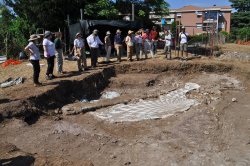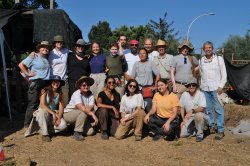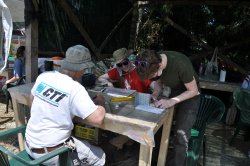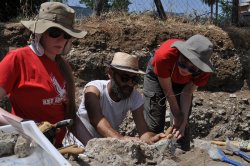Holding History in Your Hands
Faculty-led archaeological excavation lets students explore Roman imperial villa
Posted in: Faculty News, News, Student News

This summer, Dr. Deborah Chatr Aryamontri, Dr. Timothy Renner, and several students embarked on an archaeological excavation in the small town of Genzano di Roma. Since 2010, Montclair’s Center for Heritage and Archaeological Studies has been hosting this excavation of the “Villa of Antonines.” This project focuses on an important archaeological site about 18 miles southeast from the center of Rome in the ancient territory of Lanuvium, an urban center for the people of Latium. Its proximity to Rome made Lanuvium a popular location for villas, including the villa of the ancestors of the Antonine imperial dynasty.
Antonine artifacts were found in that area as early as 1701, when several marble busts of Antonine family members were unearthed. The busts are now in the Capitoline Museums in Rome. This led to the name “Villa degli Antonini,” or “Villa of Antonines.” Dr. Renner, a professor in Classics and Humanities and director of the Center for Heritage and Archaeological Studies, explains that “the name Villa of the Antonines is justified… We have an amphitheater that we discovered, and we know that one of the Antonine emperors, Commodus… the supposed emperor in Gladiator, fought wild animals at an arena in Lanuvium, and this is the only arena in Lanuvium that we know of.”

This amphitheater is mentioned in a few ancient texts, and to find something that lines up so well with written evidence is very exciting, as Dr. Chatr Aryamontri, an associate professor in Classics and Humanities and a research associate in the Center for Heritage and Archaeological Studies, notes. She also emphasizes, “When we started the project, [the area] was not even a real site.”
Today the site is one of the least investigated Roman residences in the area. While it has been neglected and underappreciated for its historic significance, in 2010 the Center for Heritage and Archaeological Studies began investigating small sectors within the Villa. “We decided it would be a great idea to continue an investigation that never really started,” Chatr Aryamontri says.
The excavation work initially focused on unearthing the amphitheater, although a residential area and bathhouse have also been discovered. The imperial villa itself was massive, as it was meant to entertain hundreds of people. “It’s a place where the emperor resided, but at the same time also entertained his entourage,” emphasizes Chatr Aryamontri.
There have also been various archaeological finds, including glass mosaics. “We found some nice mosaic flooring with Medusa designs… we found some fragments of wall paintings, wall fresco, that kind of thing,” says Renner. In 2014, the program expanded to two areas on site, allowing for more excavation and examination of these fascinating relics.

When conceptualizing the project, Chatr Aryamontri and Renner always intended it as an experience for students, and the program sees students from Montclair as well as other institutions apply for the trip. Often American universities will join with Italian universities, but this archaeological excavation is run entirely by Montclair.The trip, open to students in all majors, seeks to demystify the archaeological process for its students, and brings the glamorized field back to reality.
“It’s not just ‘let’s go and dig holes,’” says Chatr Aryamontri.“Since the very beginning, it was open to everybody, any kind of student. The idea was… to make this excavation a lifetime experience… We really believed in having this program for any kind of student.”
Chatr Aryamontri encourages all students, regardless of major, to apply. The program offers a once-in-a-lifetime opportunity that fosters teamwork, flexibility and provides a real look at an archaeological site. It also leaves a lasting impact on students. “A student told us, ‘I’m holding history in my hand,’” says Chatr Aryamontri.

For Amie Sexton, a student who participated in the Villa of Antonines project, this trip was “a lesson in self-realization.” Sexton hopes to go into archaeology professionally, and found the project to be an excellent way to gain work and life experience. She also suggests that any students looking to go on the trip prepare for heat and dust, as students spend hours in the sun at the excavation trenches. Sexton emphasizes the novelty of the excursion, saying, “It’s cliche to say that you can do anything you put your mind to, but having actually seen this program through, it feels like a whole world has opened up to me.”
Students interested in learning more or participating in the Villa of the Antonines Field School can visit the website or contact Dr. Renner or Dr. Chatr Aryamontri.
Written by Faith Monesteri, Fulcomer Intern
